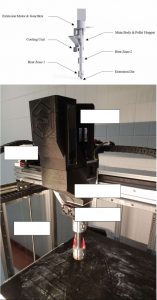In an attempt to mitigate the environmental impact of 3D printing, several organizations have taken to creating recycled filament, made not only from failed prints but from water bottles and other garbage. Inexpensive filament extruders are also available to allow makers to make their own filament from recyclable materials. Not only does recycled filament help the environment, but it also helps 3D printer users to save money and be more self-sufficient, making the technology more viable in remote communities.
3D printer manufacturer re:3D has been working on making their Gigabot 3D printer capable of printing with recycled materials, for the purpose of helping those in remote communities to become more self-sufficient. In a paper entitled “Fused Particle Fabrication 3-D Printing: Recycled Materials’ Optimization and Mechanical Properties,” a team of researchers used an open source prototype Gigabot X 3D printer to test and optimize recycled 3D printing materials.
In the study, virgin PLA pellets and prints were analyzed and compared to four recycled polymers: PLA, ABS, PET and PP.
“The size characteristics of the various materials were quantified using digital image processing,” the researchers explain. “Then, power and nozzle velocity matrices were used to optimize the print speed, and a print test was used to maximize the output for a two-temperature stage extruder for a given polymer feedstock. ASTMtype 4 tensile tests were used to determine the mechanical properties of each plastic when they were printed with a particle drive extruder system and were compared with filament printing.”
 The Gigabot X showed itself to be able to print materials 6.5 to 13 times faster than conventional 3D printers depending on the material, with no significant reduction in mechanical properties. This is significant because each time a polymer is heated and extruded, whether during the filament creation process or the 3D printing process, its mechanical properties are degraded. One option to reduce degradation, the researchers explain, is to 3D print directly from scraps, or particles, of recycled plastic.
The Gigabot X showed itself to be able to print materials 6.5 to 13 times faster than conventional 3D printers depending on the material, with no significant reduction in mechanical properties. This is significant because each time a polymer is heated and extruded, whether during the filament creation process or the 3D printing process, its mechanical properties are degraded. One option to reduce degradation, the researchers explain, is to 3D print directly from scraps, or particles, of recycled plastic.
The Gigabot X was also capable of 3D printing with a wide range of particle sizes and distributions, which opens up more possibilities for the use of materials other than pellets and filament. The processing of the materials was minimal – they only needed to be cleaned and ground or shredded. Mechanical testing using tensile strength was performed and showed that the polymer properties were not degraded; however, the researchers suggest that further mechanical testing should be performed to test properties such as compression, impact resistance, fracture toughness, creep testing, fatigue testing, and flexural strength.
There are a few limitations with the prototype Gigabot X, including lower than normal resolution in the XY plane. Due to the high heat transfer rates from the large contact area of the printer’s hotend, parts that are less than 20 mm x 20 mm cannot be 3D printed reliably. The Gigabot X also currently lacks a part cooling system, so it is limited in the geometries of parts that it can print. However, it is still a prototype, and so can be considered a work in progress.
Authors of the paper include Aubrey L. Woern, Dennis J. Byard, Robert B. Oakley, Matthew J. Fiedler, Samantha L. Snabes and Joshua M. Pearce.
Discuss this and other 3D printing topics at 3DPrintBoard.com or share your thoughts below.
Subscribe to Our Email Newsletter
Stay up-to-date on all the latest news from the 3D printing industry and receive information and offers from third party vendors.
Print Services
Upload your 3D Models and get them printed quickly and efficiently.
You May Also Like
Making Space: Stratasys Global Director of Aerospace & Defense Conrad Smith Discusses the Space Supply Chain Council
Of all the many verticals that have been significant additive manufacturing (AM) adopters, few have been more deeply influenced by the incorporation of AM into their workflows than the space...
EOS in India: AM’s Rising Star
EOS is doubling down on India. With a growing base of aerospace startups, new government policies, and a massive engineering workforce, India is quickly becoming one of the most important...
PostProcess CEO on Why the “Dirty Little Secret” of 3D Printing Can’t Be Ignored Anymore
If you’ve ever peeked behind the scenes of a 3D printing lab, you might have caught a glimpse of the post-processing room; maybe it’s messy, maybe hidden behind a mysterious...
Stratasys & Automation Intelligence Open North American Tooling Center in Flint
Stratasys has opened the North American Stratasys Tooling Center (NASTC) in Flint, Michigan, together with automation integrator and software firm Automation Intelligence. Stratasys wants the new center to help reduce...




































